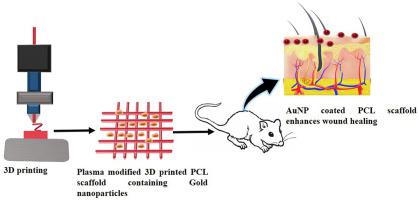当前位置:
X-MOL 学术
›
Compos. Sci. Technol.
›
论文详情
Our official English website, www.x-mol.net, welcomes your feedback! (Note: you will need to create a separate account there.)
Insights into the biomechanical properties of plasma treated 3D printed PCL scaffolds decorated with gold nanoparticles
Composites Science and Technology ( IF 9.1 ) Pub Date : 2021-01-01 , DOI: 10.1016/j.compscitech.2020.108544 Blessy Joseph , Neethu Ninan , Rahul Madathiparambil Visalakshan , Clement Denoual , Richard Bright , Nandakumar Kalarikkal , Yves Grohens , Krasimir Vasilev , Sabu Thomas
Composites Science and Technology ( IF 9.1 ) Pub Date : 2021-01-01 , DOI: 10.1016/j.compscitech.2020.108544 Blessy Joseph , Neethu Ninan , Rahul Madathiparambil Visalakshan , Clement Denoual , Richard Bright , Nandakumar Kalarikkal , Yves Grohens , Krasimir Vasilev , Sabu Thomas

|
Abstract Tissue engineered constructs having desired biomimetic and mechanical properties emerged due to the complexities involved in conventional skin grafting. They facilitate tissue regeneration without compromising mechanical properties. Herein, we report the fabrication of polycaprolactone (PCL) scaffold by fused deposition modeling and immobilization of gold nanoparticles onto the polymer surface after modifying the PCL surface using plasma polymerization. 3D printed PCL scaffolds inlaid with gold nanoparticles (Au-PCL) were characterized for their structural and mechanical properties using FESEM, and nano-indentation. The surface chemistry was analyzed using X-ray photon electron spectroscopy (XPS), wettability was determined using water contact angle studies and surface topography was imaged by atomic force microscopy (AFM). The surface modification of 3D printed scaffolds significantly improved their hydrophilicity suggesting that hydrophobicity which restricts the use of PCL in biological applications could be overcome by plasma modification. Nanoindentation studies showed that Au-PCL scaffolds exhibited remarkable enhancement in mechanical properties with reduced Young's modulus of 1.81 GPa. Biocompatibility was assessed by measuring cell viability, cell attachment and immune response. In vitro biocompatibility studies indicated good attachment of viable cells onto the gold nanoparticles incorporated 3D printed network. Immune response studies indicated that scaffolds did not enhance the production of pro-inflammatory cytokines such as TNF-α, IL-8 and IL-β. Collectively, plasma modification and surface immobilization of gold nanoparticles onto the 3D printed PCL scaffold is a simple and cost-effective technique to enhance the mechanical properties and biocompatibility of hydrophobic scaffolds like PCL, thereby making this technique a very promising tool for futuristic applications of scaffolds.
中文翻译:

深入了解用金纳米粒子装饰的等离子体处理的 3D 打印 PCL 支架的生物力学特性
摘要 由于传统皮肤移植所涉及的复杂性,出现了具有所需仿生和机械性能的组织工程构建体。它们在不影响机械性能的情况下促进组织再生。在此,我们报告了在使用等离子体聚合修饰 PCL 表面后,通过熔融沉积建模和将金纳米粒子固定在聚合物表面上来制造聚己内酯 (PCL) 支架。使用 FESEM 和纳米压痕对镶嵌有金纳米粒子 (Au-PCL) 的 3D 打印 PCL 支架的结构和机械性能进行表征。使用 X 射线光子电子能谱 (XPS) 分析表面化学,使用水接触角研究确定润湿性,并通过原子力显微镜 (AFM) 成像表面形貌。3D 打印支架的表面改性显着提高了其亲水性,这表明限制 PCL 在生物应用中使用的疏水性可以通过等离子体改性来克服。纳米压痕研究表明,Au-PCL 支架的机械性能显着增强,杨氏模量降低了 1.81 GPa。通过测量细胞活力、细胞附着和免疫反应来评估生物相容性。体外生物相容性研究表明活细胞很好地附着在包含 3D 打印网络的金纳米颗粒上。免疫反应研究表明,支架不会增加促炎细胞因子如 TNF-α、IL-8 和 IL-β 的产生。总的来说,
更新日期:2021-01-01
中文翻译:

深入了解用金纳米粒子装饰的等离子体处理的 3D 打印 PCL 支架的生物力学特性
摘要 由于传统皮肤移植所涉及的复杂性,出现了具有所需仿生和机械性能的组织工程构建体。它们在不影响机械性能的情况下促进组织再生。在此,我们报告了在使用等离子体聚合修饰 PCL 表面后,通过熔融沉积建模和将金纳米粒子固定在聚合物表面上来制造聚己内酯 (PCL) 支架。使用 FESEM 和纳米压痕对镶嵌有金纳米粒子 (Au-PCL) 的 3D 打印 PCL 支架的结构和机械性能进行表征。使用 X 射线光子电子能谱 (XPS) 分析表面化学,使用水接触角研究确定润湿性,并通过原子力显微镜 (AFM) 成像表面形貌。3D 打印支架的表面改性显着提高了其亲水性,这表明限制 PCL 在生物应用中使用的疏水性可以通过等离子体改性来克服。纳米压痕研究表明,Au-PCL 支架的机械性能显着增强,杨氏模量降低了 1.81 GPa。通过测量细胞活力、细胞附着和免疫反应来评估生物相容性。体外生物相容性研究表明活细胞很好地附着在包含 3D 打印网络的金纳米颗粒上。免疫反应研究表明,支架不会增加促炎细胞因子如 TNF-α、IL-8 和 IL-β 的产生。总的来说,



























 京公网安备 11010802027423号
京公网安备 11010802027423号